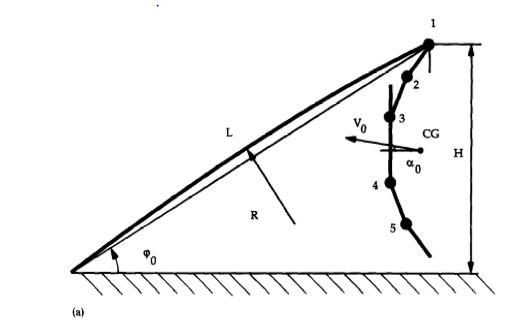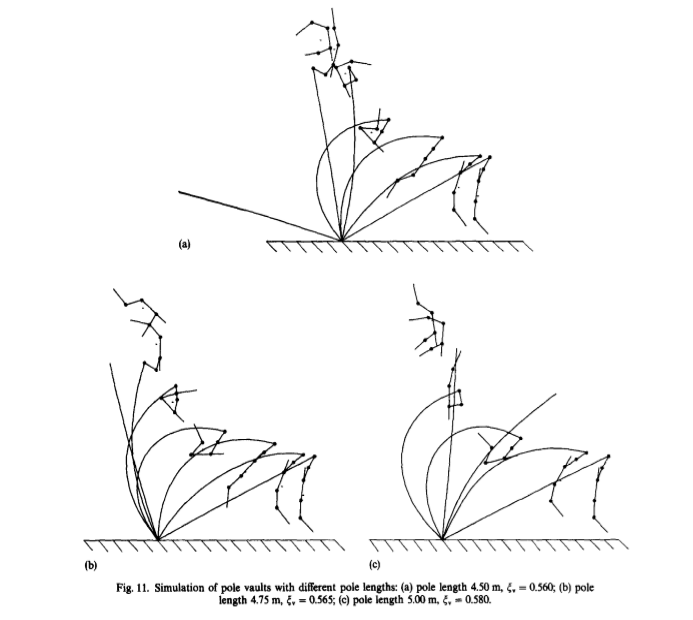Hi, I am stressing over a class project I have to do. I got myself way in over my head with this one. I am trying to simulate pole vaulting through the use of FEA with ANSYS. My professor is new to the topic and has not been able to help me much. All I have to go off of, that I consider useful, is a research paper "SIMULATION OF ‘SMART’ POLE VAULTING" by Mats Ekevad and Bengt Lundberg. This paper is actually really cool because the authors have done exactly what I am trying to do. However, because I am new to this, I am left with very little to go off of in terms of creating the actual models and setting the proper loads and constraints. I was really hoping someone here has a better understanding than I do and could help me out. If there are tutorials that I can use to piece my project together or if someone has done anything similar. I am really stuck and have exhausted just about all other resources that I can think of.
The overall goal of my project is to accurately simulate pole vault as best I can in order to determine the optimal pole length for any given vaulter.
The gist of the paper:
The pole is considered to be a one-dimensional beam with transverse shear, large displacements, large strains, and rotary as well as transverse inertia. Pin joints connect the bottom end of the pole to the ground and the top end of the pole to the vaulter. The pole is modeled using 20 equally long two-node beam elements. The initial velocity of the pole is taken to be the same as that of the vaulter except at the box end which is simply supported. It has a variably thin-walled pip cross-section, with three layers of linearly elastic materials (glass fibre).
The vaulter model consists of 6 segments with five pin joints. The two legs of the vaulter are modeled as a single, two segment leg. The same is true for the two arms.
Here's an image of the initial stance of the pole vaulter

UPDATE: By placing a point mass located at the vaulter's center of gravity I was able to accurately mimic the pole's motion
Here's an image of essentially the goal of what I want my simulation to look it.

If you have absolutely no idea what pole vaulting is. Here's a quick link to give you a good idea on what pole vault entails from an engineering perspective.
Link
At this point in time I have close to nothing completed that gets me closer to my goal. I have modeled the geometry of the pole and the vaulter using simple line bodies in ANSYS DesignModeler. Instead of trying to create the three elastic layers of the pole, I used a single layer and am treating it as a uniform material with material properties similar to that of the composite. When I try to apply an sort of loads, the outcome does not even come close to what I was expecting. Right now it appears that when my pole is supposed to bend, it collapses in on itself and shrinks, then recoils back to its original shape. When I add in gravitational effects, it gets even worse. Everything just falls.
The overall goal of my project is to accurately simulate pole vault as best I can in order to determine the optimal pole length for any given vaulter.
The gist of the paper:
The pole is considered to be a one-dimensional beam with transverse shear, large displacements, large strains, and rotary as well as transverse inertia. Pin joints connect the bottom end of the pole to the ground and the top end of the pole to the vaulter. The pole is modeled using 20 equally long two-node beam elements. The initial velocity of the pole is taken to be the same as that of the vaulter except at the box end which is simply supported. It has a variably thin-walled pip cross-section, with three layers of linearly elastic materials (glass fibre).
The vaulter model consists of 6 segments with five pin joints. The two legs of the vaulter are modeled as a single, two segment leg. The same is true for the two arms.
Here's an image of the initial stance of the pole vaulter

UPDATE: By placing a point mass located at the vaulter's center of gravity I was able to accurately mimic the pole's motion
Here's an image of essentially the goal of what I want my simulation to look it.

If you have absolutely no idea what pole vaulting is. Here's a quick link to give you a good idea on what pole vault entails from an engineering perspective.
Link
At this point in time I have close to nothing completed that gets me closer to my goal. I have modeled the geometry of the pole and the vaulter using simple line bodies in ANSYS DesignModeler. Instead of trying to create the three elastic layers of the pole, I used a single layer and am treating it as a uniform material with material properties similar to that of the composite. When I try to apply an sort of loads, the outcome does not even come close to what I was expecting. Right now it appears that when my pole is supposed to bend, it collapses in on itself and shrinks, then recoils back to its original shape. When I add in gravitational effects, it gets even worse. Everything just falls.

![[glasses] [glasses] [glasses]](/data/assets/smilies/glasses.gif) Just traded in my OLD subtlety...
Just traded in my OLD subtlety...![[tongue] [tongue] [tongue]](/data/assets/smilies/tongue.gif)